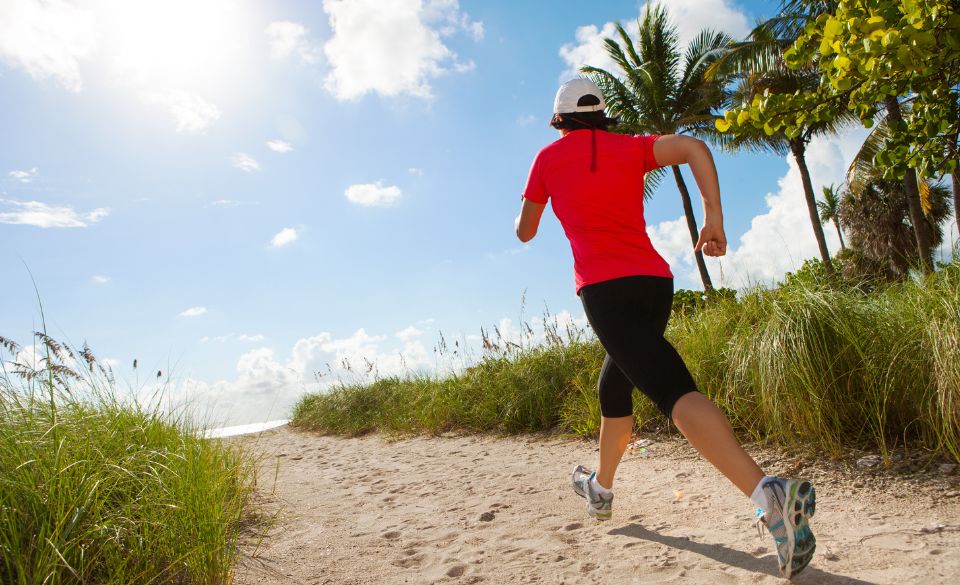
Running In the Sun: Benefits and Challenges
Page Contents
Running is a popular form of exercise that not only enhances physical fitness but also contributes to mental well-being. While many runners prefer hitting the road or treadmill, incorporating outdoor runs under the sun can offer a myriad of advantages. In this article, we will explore the benefits of running in the sun, supported by scientific studies, and shed light on essential precautions to ensure a safe and enjoyable experience.
Benefits of Running in the Sun
While hitting the road or treadmill are common choices, incorporating outdoor runs in the sun can bring additional advantages. Below are the top benefits of running in the sun:
Vitamin D Boost: Strengthening Body and Bones
Running in the sun exposes your skin to ultraviolet B (UVB) radiation, which stimulates the synthesis of vitamin D in your body. Vitamin D plays a crucial role in maintaining optimal health, including the absorption of calcium for strong bones and teeth. A study published in the Journal of Clinical Endocrinology & Metabolism found that individuals who engaged in outdoor activities, such as running in the sun, experienced a significant increase in vitamin D levels, promoting bone health and reducing the risk of conditions like osteoporosis.
Mood Elevation: Harnessing the Power of Sunshine
Sunlight has long been associated with improved mood and enhanced mental well-being. When you run outdoors in the sun, your body absorbs natural light, which triggers the release of serotonin in the brain. Serotonin is a neurotransmitter known to regulate mood and contribute to feelings of happiness and well-being. A study conducted by researchers at the University of Sydney found that exposure to natural light during exercise, such as running in the sun, led to increased serotonin production and improved mood compared to indoor exercise.
Enhanced Energy and Performance: The Sun as Your Ally
Exercising in natural light can provide a significant energy boost for runners. Sunlight exposure stimulates the production of adenosine triphosphate (ATP), the primary source of energy for cellular processes in the body. A study published in the Journal of Sports Sciences revealed that athletes who trained outdoors under natural light reported higher energy levels, improved endurance, and enhanced performance compared to those who exercised solely indoors.
Immune System Support: Sunlight for Strengthened Defenses
Sunlight exposure during outdoor running can positively impact your immune system. Research published in the International Journal of Environmental Research and Public Health suggests that sunlight can enhance the function of immune cells and increase the production of vitamin D, which plays a crucial role in immune system regulation. Regular outdoor exercise, including running in the sun, can help bolster your immune defenses, reducing the risk of infections and promoting overall health.
Better Sleep Quality: Sunlit Runs for Restful Nights
Sunlight exposure during outdoor runs can also improve sleep quality. The body’s internal clock, known as the circadian rhythm, is influenced by natural light. Running in the sun helps regulate the circadian rhythm, promoting better sleep-wake cycles. A study published in the Journal of Clinical Sleep Medicine found that exposure to natural light during daytime physical activity, such as running, resulted in improved sleep quality and reduced time to fall asleep, leading to more restful nights.
Precautions for Safe Running in the Sun:
Running under the sun can be an invigorating and enjoyable experience. However, it is crucial to prioritize your health and take necessary precautions to ensure a safe and protected running session. Below are some precautions to stay safe when running in the sun:
Sunscreen: Shielding Your Skin from Harmful Rays
One of the primary concerns while running in the sun is overexposure to ultraviolet (UV) radiation, which can lead to sunburns, premature aging, and an increased risk of skin cancer. The American Academy of Dermatology recommends using a broad-spectrum sunscreen with a sun protection factor (SPF) of 30 or higher. Applying sunscreen before heading out can significantly reduce the harmful effects of UV radiation. A study published in the Journal of the American Academy of Dermatology demonstrated that regular sunscreen use reduced the incidence of melanoma, the deadliest form of skin cancer, by 50%.
Protective Clothing: Defending Against UV Rays
In addition to sunscreen, wearing protective clothing is essential to shield your skin from direct sunlight. Opt for lightweight and breathable fabrics that cover exposed areas of the body, such as long-sleeved shirts, wide-brimmed hats, and sunglasses with UV protection. A study published in the Journal of the American Academy of Dermatology found that wearing sun-protective clothing significantly reduced the risk of sunburn, especially when combined with sunscreen application.
Timing Your Runs: Avoiding Peak Sunlight Hours
Choosing the right time for your outdoor runs can make a significant difference in sun exposure. It is advisable to schedule your runs during the early morning or late afternoon when the sun’s intensity is lower. The National Health Service (NHS) in the UK suggests avoiding running between 11 a.m. and 3 p.m., as this is when the sun is at its strongest. Research published in the Journal of Applied Physiology showed that exercising in hot environments during peak hours increased the risk of heat-related illnesses, emphasizing the importance of timing for safe running in the sun.
Hydration: Quenching Your Body’s Needs
Staying adequately hydrated is crucial for maintaining performance and preventing heat-related illnesses while running in the sun. Sweating during exercise leads to fluid loss, which can result in dehydration if not replenished. The American College of Sports Medicine recommends drinking water before, during, and after your runs. A study published in the Journal of Athletic Training highlighted that dehydration impairs exercise performance and increases the risk of heat-related illnesses, underscoring the importance of maintaining proper hydration levels.
Listen to Your Body: Recognizing Signs of Overexertion
While enjoying your outdoor runs, it is vital to listen to your body and be aware of signs of overexertion or heat-related illnesses. Symptoms such as dizziness, nausea, headache, muscle cramps, and excessive sweating may indicate heat exhaustion or heatstroke. If you experience any of these symptoms, it is crucial to seek shade, rest, and hydrate. A study published in the Journal of Science and Medicine in Sport highlighted the importance of recognizing early signs of heat illness and taking appropriate measures to prevent severe consequences.
Tips For Running in the sun
Time Your Runs Wisely: Avoid the Peak Sun Hours
Timing your runs is key to minimize sun exposure and reduce the risk of overheating or sunburn. Aim to run early in the morning or late in the afternoon when the sun’s intensity is lower. Avoid running during peak hours, typically between 10 a.m. and 4 p.m., when the sun is at its strongest. This strategy allows you to enjoy the benefits of sunlight while minimizing the potential hazards associated with excessive heat and UV radiation.
Dress Appropriately: Optimize Protection and Comfort
Choosing the right clothing can significantly enhance your sunlit running experience. Opt for lightweight, breathable fabrics that provide adequate coverage and protection from the sun. Consider wearing moisture-wicking materials that help regulate body temperature and prevent discomfort caused by sweat. Long-sleeved shirts, hats with wide brims, and sunglasses with UV protection are essential for shielding your skin and eyes from harmful rays. Don’t forget to apply sunscreen to any exposed skin for additional protection.
Stay Hydrated: Quench Your Thirst for Peak Performance
Proper hydration is vital for maintaining performance and preventing dehydration while running in the sun. Drink plenty of fluids before, during, and after your runs. Start hydrating well in advance, even before you feel thirsty. Water is typically sufficient for shorter runs, but for longer or more intense sessions, consider electrolyte-rich sports drinks to replenish essential minerals lost through sweat. Remember, maintaining proper hydration levels helps regulate body temperature and ensures optimal physical performance.
Plan Your Route: Seek Shade and Cooler Environments
When running in the sun, choose routes that offer shade or cooler environments. Seek out trails with tree cover or opt for urban routes with buildings that provide shade. Running on asphalt can significantly increase the heat around you, so try to incorporate grassy or shaded areas into your route whenever possible. Planning your route strategically helps to reduce the risk of overheating and sunburn, making your run more enjoyable and safer.
Listen to Your Body: Recognize Warning Signs and Adjust Accordingly
Your body provides valuable feedback while running, and it’s essential to listen to its signals. Be mindful of signs of overheating or heat-related illnesses, such as dizziness, nausea, excessive fatigue, or muscle cramps. If you experience any of these symptoms, slow down, find shade, and take a break to cool off. Adjust your pace or shorten your run if needed. It’s important to prioritize your well-being and make adjustments accordingly to ensure a safe running experience.
Summing Up
Running in the sun offers a multitude of benefits for both physical and mental well-being. From boosting vitamin D levels and enhancing mood to improving energy, performance, immune function, and sleep quality, the advantages are undeniable. However, it is crucial to prioritize safety and take precautions to protect yourself from excessive heat and harmful UV radiation.
By following the essential tips for running in the sun, such as timing your runs wisely, dressing appropriately, staying hydrated, planning your route, and listening to your body, you can optimize your experience and minimize the risks associated with sun exposure. Remember to apply sunscreen, wear protective clothing, stay hydrated, seek shade, and be mindful of your body’s signals.
Running in the sun can be a rejuvenating and invigorating experience, allowing you to connect with nature and enjoy the outdoors. Embrace the warmth and energy of the sun, while keeping your well-being in mind. So, lace up your running shoes, step outside, and embark on sunlit runs, knowing that you’ve taken the necessary steps to ensure a safe and enjoyable journey towards better health and fitness.




